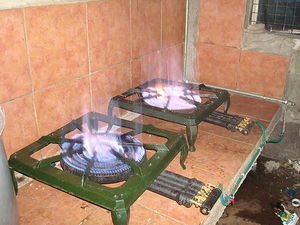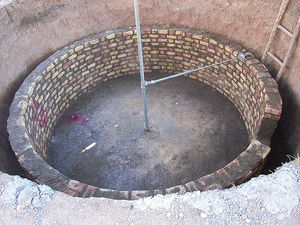Biogas: Difference between revisions
m (→Applications) |
m (→Applications) |
||
| Line 14: | Line 14: | ||
* The CO2 contained in biogas can be used in inside a greenhouse and can provide a boost to plant growth (CO2 concentrations up to 1500ppm are beneficial). This is effect widely used by commercial growers, but unfortunately they are using mostly fossil methane. | * The CO2 contained in biogas can be used in inside a greenhouse and can provide a boost to plant growth (CO2 concentrations up to 1500ppm are beneficial). This is effect widely used by commercial growers, but unfortunately they are using mostly fossil methane. | ||
* Various uses in [[:Category:Metalworks|metallurgy]] | * Various uses in [[:Category:Metalworks|metallurgy]] | ||
* [[CNC_Torch_Table_Control_Overview# | * [[CNC_Torch_Table_Control_Overview#Oxy-propane.2C_-natural_gas.2C_etc| Oxy-fuel torch cutting]] | ||
== To think about == | == To think about == | ||
Revision as of 04:24, 15 August 2013
A gas produced by the breakdown of organic matter in the absence of oxygen.
Applications
- Used for cooking, heating, electrical generation
- Production of Direct reduced iron from rust or high-grade iron ore.
- Compressed and cleaned biogas for transportation with internal combustion engines
- Liquid slurry from digester tank can be used to fertilize duckweed pond
- Solid contents coming out of digester can be composted (vermicompost, BSF compost, biochar compost)
- The CO2 contained in biogas can be used in inside a greenhouse and can provide a boost to plant growth (CO2 concentrations up to 1500ppm are beneficial). This is effect widely used by commercial growers, but unfortunately they are using mostly fossil methane.
- Various uses in metallurgy
- Oxy-fuel torch cutting
To think about
- Biogas production may need insulation or earth sheltering when used in cold climates witch could otherwise lead to breakdown of microbial populations. With CEB-blocks and insulation and option of heating, this is a design issue.
- Biogas can contain some sulfur (that smells like rotting eggs) and it is then not recommended to be used in engines for a prolonged time. The sulfuric acid can accumulate in the engine oil and it will need replacing and or cleaning after a while. To avoid some of this do not feed the digester with objects that generate this gas like plasterwalls.. There exists some additive that can limit this but should not be needed in this case. When used for direct burning like with a gas-nozzle for cooking it can be used directly. But some don't like that smell when cooking.
- Compressing into gas cylinders if needed for mobile transportation and more easy handling.
- Create smaller pieces of bulky biomass before it go into the digester to make it more effective, Could be using the hammer mill
Biodigester
A sealed container that carries out the anaerobic digestion process. It needs to be able to separate and remove the liquid and gas phases and have an entrance/exit for the substrate. Sometimes heated and stir the content to produce even more. Some new digesters have a step before the liquid is exiting the digester there it is heated up to 70 degree Celsius to remove some more of possible pathogens that could have survived.
- Guastavino masonry or plain CEBs to build biogas digester and holding tank for stored biogas. One holding tank could be used for the storage of biogas and Compressed fuel gas.
Cleaning or upgrading
Biogas need cleaning or upgrading to remove as much as possible of the contained sulfur and or carbon dioxide and make a higher energy value. To be able to use it in engines for mobile gas-car transportation or electrical generation and limit corrosion and wear in motors. It is also possible to feed the cleaned carbon dioxide to the green house.
Simple Open Source Biogas System
Supergas - In 1996-97 Superflex collaborated with biogas engineer Jan Mallan to construct a simple, portable biogas unit that can produce sufficient gas for the cooking and lighting needs of an African family. The system has been adapted to meet the efficiency and style demands of a modern African consumer. It is intended to match the needs and economic resources that we believe exist in small-scale economies. The orange biogas plant produces biogas from organic materials, such as human and animal stools. For a modest sum, a family will be able to buy such a biogas system and achieve self-sufficiency in energy. The plant produces approx. 3-4 cubic meters of gas per day of the dung from 2-3 cattle. This is enough for a family of 8-10 members for cooking purposes and to run one gas lamp in the evening.
External Links
- Wikipedia:Biogas
- Appropedia Category: Biogas
- Appropedia main biogas page
- Wikipedia: Biogas
- p2pfoundation Category:Biofuel
- DIY Biogas - Germany


